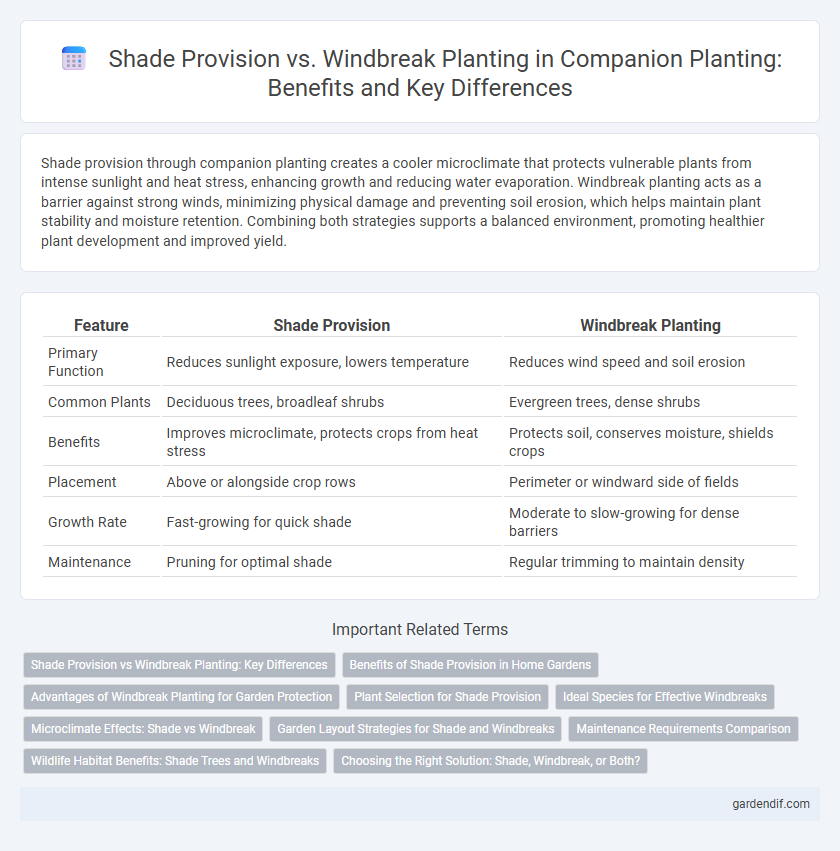
Shade provision vs windbreak planting Illustration
Shade provision through companion planting creates a cooler microclimate that protects vulnerable plants from intense sunlight and heat stress, enhancing growth and reducing water evaporation. Windbreak planting acts as a barrier against strong winds, minimizing physical damage and preventing soil erosion, which helps maintain plant stability and moisture retention. Combining both strategies supports a balanced environment, promoting healthier plant development and improved yield.
Table of Comparison
| Feature | Shade Provision | Windbreak Planting |
|---|---|---|
| Primary Function | Reduces sunlight exposure, lowers temperature | Reduces wind speed and soil erosion |
| Common Plants | Deciduous trees, broadleaf shrubs | Evergreen trees, dense shrubs |
| Benefits | Improves microclimate, protects crops from heat stress | Protects soil, conserves moisture, shields crops |
| Placement | Above or alongside crop rows | Perimeter or windward side of fields |
| Growth Rate | Fast-growing for quick shade | Moderate to slow-growing for dense barriers |
| Maintenance | Pruning for optimal shade | Regular trimming to maintain density |
Shade Provision vs Windbreak Planting: Key Differences
Shade provision typically involves planting trees or structures to reduce sunlight exposure and lower temperatures, enhancing comfort in outdoor spaces. Windbreak planting focuses on creating barriers using dense rows of trees or shrubs designed to reduce wind speed and protect soil, crops, or buildings from erosion and damage. The key difference lies in their primary function: shade provision aims to block sunlight, while windbreak planting primarily targets wind reduction and protection.
Benefits of Shade Provision in Home Gardens
Shade provision in home gardens significantly reduces heat stress on plants, enhancing growth and prolonging flowering periods. It conserves soil moisture by limiting evaporation, leading to more efficient water use and healthier plant roots. Shade trees also create a microclimate that supports beneficial insects and reduces pest pressures, promoting a balanced garden ecosystem.
Advantages of Windbreak Planting for Garden Protection
Windbreak planting enhances garden protection by reducing wind speed, which minimizes soil erosion and prevents damage to delicate plants. This method improves microclimate conditions, promoting healthier growth and higher crop yields. Trees and shrubs used in windbreaks also provide habitat for beneficial insects and wildlife, contributing to ecological balance.
Plant Selection for Shade Provision
Selecting plants for shade provision involves choosing species with dense, broad canopies that efficiently block sunlight while maintaining adequate airflow. Trees like oaks (Quercus spp.) and maples (Acer spp.) offer expansive foliage ideal for reducing solar exposure, whereas shrubs such as viburnums and holly provide layered shade for understory plants. Effective shade provision requires consideration of plant maturity, leaf area index, and seasonal foliage characteristics to optimize microclimate conditions for companion crops.
Ideal Species for Effective Windbreaks
Ideal species for effective windbreaks combine dense foliage and strong structural traits to reduce wind velocity and provide reliable shade provision. Evergreen trees such as Thuja occidentalis and Pinus strobus maintain year-round protection, while deciduous species like Populus deltoides and Salix alba contribute to seasonal airflow regulation and shade during warmer months. Proper selection enhances microclimate stability, soil conservation, and overall companion plant health.
Microclimate Effects: Shade vs Windbreak
Shade provision in companion planting significantly reduces ambient temperature by blocking direct sunlight, promoting cooler microclimates that enhance plant transpiration and reduce water stress. Windbreak plantings alter airflow patterns, decreasing wind speed and minimizing evapotranspiration, which stabilizes temperature and humidity levels around crops. These microclimate modifications improve overall plant health and yield by optimizing moisture retention and reducing environmental stress.
Garden Layout Strategies for Shade and Windbreaks
Shade provision through companion planting enhances garden microclimates by strategically positioning taller plants to shield delicate species from harsh sunlight, while windbreak planting focuses on creating a barrier of dense shrubs or trees to reduce wind speed and protect crops. Effective garden layout strategies integrate shade and windbreak elements to optimize plant health, improve moisture retention, and increase overall productivity. Selecting species with complementary growth habits and spacing ensures the dual function of shade and wind protection, maximizing the garden's resilience and yield.
Maintenance Requirements Comparison
Shade provision typically requires regular pruning and monitoring to maintain canopy density and health, ensuring effective coverage and preventing overgrowth. Windbreak planting demands consistent inspection for damage and replacement of compromised plants to sustain protective functionality against wind erosion. Both methods involve ongoing upkeep, but shade provision often necessitates more frequent trimming, while windbreaks focus on plant health and structural integrity.
Wildlife Habitat Benefits: Shade Trees and Windbreaks
Shade trees provide essential wildlife habitat by offering shelter, nesting sites, and food resources for various bird and insect species. Windbreak planting enhances biodiversity by reducing wind speed, creating microclimates that support diverse plant and animal communities. Together, shade provision and windbreaks improve ecosystem health by fostering habitats that sustain pollinators, small mammals, and other native wildlife.
Choosing the Right Solution: Shade, Windbreak, or Both?
Selecting between shade provision and windbreak planting depends on specific environmental conditions and desired microclimate improvements. Shade trees reduce solar radiation and lower temperatures, ideal for protecting sensitive plants from heat stress, while windbreaks effectively reduce wind speed, minimizing moisture loss and soil erosion. Combining both strategies offers synergistic benefits, enhancing plant growth and resilience by simultaneously controlling light, temperature, and wind exposure.
Shade provision vs windbreak planting Infographic

 gardendif.com
gardendif.com